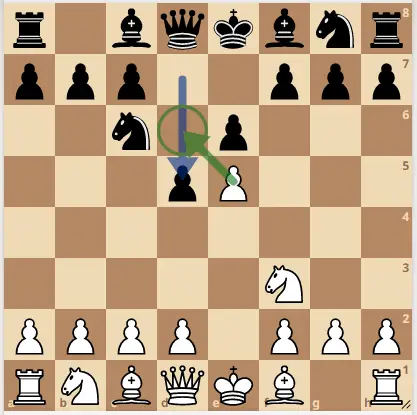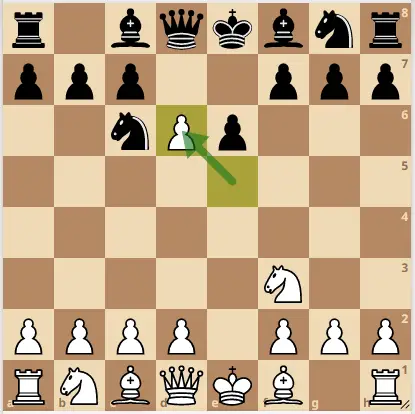En passant. You’ve probably seen and heard of this strange move before but want to know the validity of this move. The word “en passant” is actually a French term which means “in passing”. It was introduced to the game of chess in 1561. However, many players want to know whether or not it was officially accepted in the rule book.
How legal of a move is en passant and is it recognized under FIDE laws of chess? Here is what you should know:
Is En Passant Legal In Chess?
Though en passant may seem like a strange move at first sight, it’s actually 100% legal under the FIDE laws of chess. Under section 3.7 (d) you can capture an opponent’s pawn if it moves 2 squares from its starting position and lands beside your pawn. You capture the opponent’s pawn diagonally on the square that it passed over as if it had only moved one square.
In the following position, black just advanced his d pawn 2 squares forward. White’s e pawn can capture black’s d-pawn via en passant.
Before en passant

After en passant

When Is En Passant Illegal?
En passant is only legal on the move following the advance. This means en passant can only be done immediately and is illegal on any other move after that.
Therefore, if you get the chance to perform en passant and it leads to a positional advantage, then you should definitely play it right away. Otherwise, you won’t get back that opportunity again.
The pawn is pinned
Another scenario where en passant is illegal is if the pawn is pinned to the king. A pawn that is doing defensive duties cannot leave the king unprotected, else the king would be captured on the next move. Therefore, this would be illegal.
For example, in the following position, black just played the move d5. It would be illegal for white to perform en passant here because the black queen is pinning white’s pawn to the king.

So what is the purpose of en passant you may ask? Here are 2 plausible reasons why the en passant rule was created:
Why Was En Passant Rule Created?
There are 2 main reasons why the en passant rule was introduced to the FIDE laws of chess:
1. Prevent the position from locking up
Without this special move “en passant” a lot of chess games would get locked up. In other words, the position will get closed and this prevents both sides from making progress. This will probably lead to a lot of draws which would make the chess game less interesting and less fun.
However, when the position is opened, players have the ability to move their pieces freely and create strategic plans in the middlegame. This makes for a more exciting game of chess as the pieces are not locked behind pawns.
2. Prevents The Enemy Pawn From Evading Capture
The second reason why en passant exist as a rule is to stop your opponent’s pawn from evading capture. It would be unfair if your opponent could simply move his pawn 2 squares from the starting position and land it next to your pawn without it being captured.
In the beginning of chess, pawns could only move one square, but the creators thought that this would be too slow in the opening phase of the game.
As a result, they made the pawns move 2 squares forward only on their first move in order to speed up things a bit since the pawn would have to make 2 moves to get to the center of the board. After they made this rule they realized that the pawns could bypass or evade capture on their first move by moving 2 squares forward.
Therefore, en passant was introduced to prevent this from happening.
How Many Times Can You En Passant?
Unlike castle that only happens once, you have more than one opportunity to en passant over the board. However a single pawn will only have a maximum of 2 possible opportunities to en passant with the exception of the flank pawns. The flank pawns only have one opportunity to en passant.
Flank pawns on the wing has one opportunity to en passant

The other pawns have 2 opportunities to en passant

When Is It Bad To En Passant?
Not all the times it is good to en passant in chess, even though it helps to prevent the position from closing up.
In some positions where the king is still not castled, it would not be wise to en passant as this would open up lines in front of the uncastled king. This could lead to attacks against the king. Always make sure that your king is castled or in a safe position before opening up the position.
However, if your king is still remained in the center but your opponent does not have enough of his pieces developed to threaten the king, then you could consider en passant given that the move improves upon your position.
Another time en passant is bad is if it increases the activity of your opponent’s pieces or helps with the development of his pieces. You could en passant and open lines for your opponent’s pieces that he could not have resolved by himself. Therefore, always stop to think how this move would affect your position and your opponent’s position as well.
The United States Chess Federation Jurisdiction
While FIDE is the governing body of chess, other countries do have their own jurisdictions when it comes to chess rules. The U.S.C.F which is the governing chess body of the United States and the second largest chess federation after FIDE holds differing views on some of the laws of chess. For example, in the touch move rule, FIDE strictly holds the view that if you touch a piece without saying adjust, then you have to move that piece.
U.S.C.F on the other hand gives exceptions to the touch move rule which includes: “Appearance of adjustment” and “Accidental touching of piece”. However, when it comes to en passant, the rules are the same in both jurisdictions.
Under the U.S.C.F rules, capturing by en passant is legal as outlined in article 8F5 and 7C.
Article 8F5 quotes: “A pawn, attacking a square bypassed by an opponent’s pawn, the latter having advanced two squares in one move from its original square, may capture (7C) the opponent’s pawn as though the latter had moved only one square. This capture may only be made in immediate reply to such advance and is called an en passant (in passing) capture. Note that only a pawn that has advanced a total of exactly three squares from its original square is in position to make such a capture”.
As you can see, the rules of en passant are not just present in the FIDE laws of chess, but also in the U.S.C.F rule book, thereby confirming that the move ‘en passant’ is indeed legal over the chess board.
Why Is It That So Many Chess Players Do Not Know The En Passant Rule?
It is true that many chess players do not know the en passant rule. This is largely due to inexperience as it is one of the less commonly seen moves over the board.
Nevertheless, the players who wouldn’t know the rule are casual (non tournament) players or beginner level tournament players, typically young children.
It’s important when you are just starting out that you learn this move thoroughly. Though it is not seen that often, en passant is very much alive in the game of chess and is certainly not a rare move.
Every chess player should learn en passant at the beginning of their journey. Subsequently, they won’t be surprised when they see this move over the board as they would already be equipped with this knowledge.
What To Do If Your Opponent Doesn’t Know En Passant?
If your opponent doesn’t know en passant, then you politely explain to him that it is a legal move under the FIDE laws of chess and the U.S.C.F rules.
There is nothing wrong with taking the time out of the match to explain the rule to your opponent as it is clear that he doesn’t know the move. If you’re not able to explain the move to him or he believes that the move is wrong, then the arbiter or tournament director should be summoned to explain the move to the player so that the game can proceed.
Final Verdict
The international governing body of chess, FIDE, officially accepted en passant in the rule book in the year 1880. So if you are wondering if en passant is a legal move, then the answer is yes!
Nevertheless, there are certain conditions that must be met if one is to successfully en passant over the chess board.
A pawn attacking a square crossed by an opponent’s pawn which has advanced two squares in one move from its original square may capture this opponent’s pawn as though the latter had been moved only one square. This capture is only legal on the move following this advance.
Therefore, you should take the opportunity when given the chance!
Related post: 3 Special pawn moves in chess


